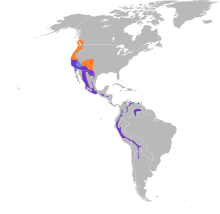Band-tailed pigeon
Species of bird From Wikipedia, the free encyclopedia
The band-tailed pigeon (Patagioenas fasciata)[3] is a pigeon native to the Americas, and the largest pigeon native to North America. They are a native species throughout the Southwestern United States and Mexico, extending south to Peru.
This article may not provide balanced coverage on a geographical region. (September 2017) |
| Band-tailed pigeon | |
|---|---|
 | |
| In San Luis Obispo, California, USA | |
| Scientific classification | |
| Domain: | Eukaryota |
| Kingdom: | Animalia |
| Phylum: | Chordata |
| Class: | Aves |
| Order: | Columbiformes |
| Family: | Columbidae |
| Genus: | Patagioenas |
| Species: | P. fasciata |
| Binomial name | |
| Patagioenas fasciata (Say, 1822) | |
 | |
| Range of P. fasciata Breeding Year-round Nonbreeding | |
| Synonyms | |
|
Columba fasciata (Say, 1823) | |
Taxonomy
Its closest living relatives are the Chilean pigeon and the ring-tailed pigeon, which form a clade of Patagioenas with a terminal tail band and iridescent plumage on their necks.[4] There are at least 8 sub-species, and some authorities split this species into the northern band-tailed pigeon (Patagioenas fasciata)[5] and the southern band-tailed pigeon (Patagioenas albilinea).[6][7]
Use as genetic proxy
The band-tailed pigeon is the closest living relative of the extinct passenger pigeon and has been investigated for use in efforts to bring back that species.[8][9]
Distribution and habitat
It ranges from British Columbia, Washington, Oregon, California, and southern Arizona south in higher elevations through Mexico and Central America to northern Argentina. In autumn it migrates out of its permanent resident range into northern California, New Mexico, and parts of Utah and Colorado. It is found from almost sea level to 3,600 m (12,000 ft), generally in oak, pine-oak, and coniferous forests. It feeds on seeds, notably acorns, as well as berries and small fruits.
Description

It is the largest pigeon in North America, measuring 33 to 40 cm (13 to 16 in) long and weighing 225–515 g (7.9–18.2 oz).[10][11] The coastal subspecies P. f. monilis (averaging 392 g (13.8 oz)) is larger than the inland subspecies (averaging 340 g (12 oz)).[10] The band-tailed pigeon has a wingspan of 66 cm (26 in).[12]
The plumage is gray, somewhat darker above. The head and underparts have a faint pink cast, especially in the adult male; the belly is nearly white. The distal half of the tail is also pale (except in the subspecies of Baja California), whence the English name. The bill and feet are yellow, with good identification marks at sufficiently close range. Adults have green iridescence on the back of the neck, adjacent to a thin white collar on the nape. Juvenile birds have white feather edges above, giving a scaly appearance.
Behavior and ecology
Summarize
Perspective

This species is relatively quiet for a pigeon. Its voice is low-pitched and owl-like, often in two-syllable calls that rise and then fall (huu-ooh) with even spacing between calls.[13] It also makes a variety of harsh squawking sounds for a variety of reasons.
It builds a rudimentary platform nest out of twigs, in which it lays one or two eggs. Outside the breeding season, it forms flocks, sometimes over 50 birds, and often becomes nomadic, following the acorn crop or moving to lower altitudes or other areas outside its breeding range. They commonly congregate at and drink from mineral springs, although it is not fully understood why. In addition to acorns and other seeds, the band-tailed pigeon will seasonally consume fruits such as Pacific madrona and Toyon berries.[14] This species often visits bird feeders. With the introduction of English holly and English ivy, two popular plants in landscaping in western North America, the bird is found in persistent numbers in suburban areas now as well.
The parasitic louse Columbicola extinctus, believed to have become extinct with the extinction of the passenger pigeon, was recently rediscovered on the band-tailed pigeon.
References
External links
Wikiwand - on
Seamless Wikipedia browsing. On steroids.


